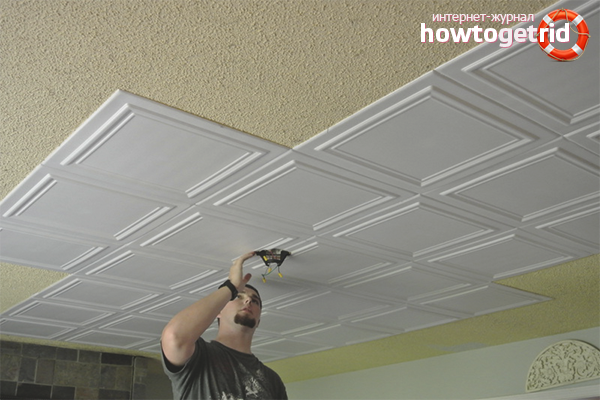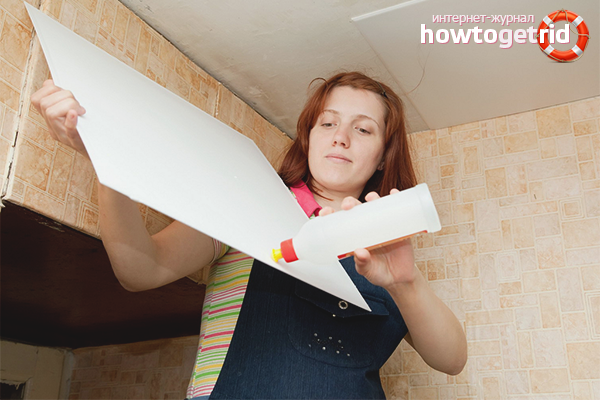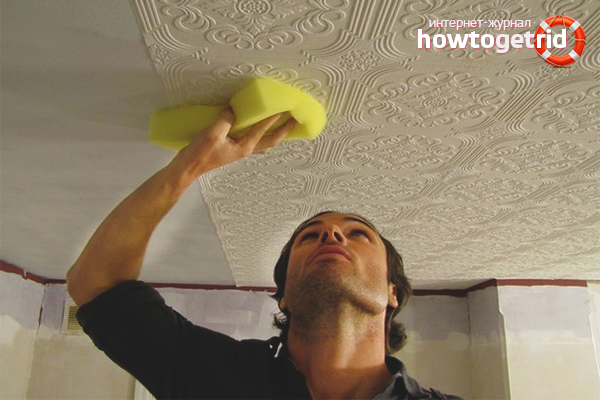The content of the article
A beautifully decorated ceiling attracts the eye of visitors, makes the room interesting and unique. One way to achieve this effect is to use ceiling tiles. Using minimal resources, you can quickly transform any room. But before you start gluing the tiles, you need to carefully prepare for this.
Ceiling surface preparation
Preparation of the surface of the ceiling will save you from possible difficulties associated with the installation of tiles. In order for the work to turn out to be high-quality, and the result is durable, follow the following instructions:
- If the ceiling has old whitewash, paint, cladding, stucco, which is streaming, wallpaper, etc., remove so that nothing interferes with the tile.
- After cleaning the surface of the ceiling, cracks, depressions, bumps, etc. may appear. Use putty to fix defects. It is ideal for leveling the ceiling, as well as for grouting damage of any complexity.
- When the putty is completely dry (after 12 hours), prime the ceiling. Apply multiple layers at intervals for drying. The primer improves adhesion and the tile holds tight.
In some cases, the ceiling is not cleaned of whitewash, but immediately proceeds to priming. So, they do it under one condition - the lime layer is in fairly good condition. This method does not guarantee a lasting result, but, as an option of quick cosmetic repairs, can be applied.
Determination of the area of the ceiling
- The ceiling area is very easy to determine. To do this, measure its length and width using a tape measure, and then multiply the resulting numbers. This method is applicable if the room is in the form of an even rectangle.
- But there are rooms that have cut corners or an L-shaped. To measure the area of a non-standard ceiling, draw a plan on a piece of paper, indicating the dimensions of all sides. Then divide the drawing into even rectangular sections. Determine the area of each rectangle and add the data. As a result, you get the total ceiling area.
Example:
You made the necessary measurements of the ceiling and received the following data: width = 4 m, length = 5 m. Multiply these numbers: 4x5 = 20 m2. Thus, the ceiling area is 20 m2.
Material quantity calculation
- To understand how much material you need to buy, first determine the area of one tile. This is done in exactly the same way as with the ceiling. Most tiles have a standard size of 50x50. Multiply this data: 0.50 x 0.50 = 0.25 m2. As a result, the area of one tile is 0.25 m2.
- Now you have the following data: 20 m2 - ceiling area and 0.25 m2 - tile area. Divide these numbers: 20 m2 / 0.25 m2 = 80 pcs. As a result, it turns out that you need to buy 80 tiles for a room of 20 m2.
But take your time to go to the store and buy just that amount of material. The fact is that during operation errors can occur that will lead to the breakdown of a certain number of tiles. Considering possible losses, buy material with a margin - 10% more.
Ways to arrange ceiling tiles
There are many ways to lay tiles on the ceiling. For example, you can arrange tiled squares in a checkerboard pattern or diagonally, combine different colors, creating simple geometric shapes. There are plenty of options, but any method requires precise marking.
They usually lay tiles from the middle (the exception is rooms with a small area where installation is carried out from the corners), so first determine the central part of the ceiling. To do this, draw diagonals with the help of threads. Then draw perpendicular lines through the center. Such marking is universal and will help arrange the tile in any convenient way.
The main ways of laying tiles:
- Diagonal. This option is often applied and suitable for any room. Drawn lines allow you to control the laying of tiles in a diagonal direction. The result is smooth and beautiful.
- Chess order. To create the effect of a chessboard, tiles of two colors are used. They begin to be glued from the center point of the ceiling, so that the edges are parallel to the walls. Checkerboard tiles hide well the imperfection of the ceiling surface.
- The snake. In this embodiment, two combined or contrasting shades of tile are used. Gluing starts from the center, creating a graphic image of a snake twisted into a spiral. If you are unable to find a material of the right color, use a water based paint.
Rules for laying ceiling tiles
- Do not glue tiles on whitewashing. This will cause the lime layers to peel off over time, and with them the tile. Before laying, you need to clean the ceiling from chalk and prime.
- Tiles are glued from the center of the ceiling or the location of the chandelier. It is necessary to control that the rows close to the walls have the same width.
- Buy tiles with a margin. For ceilings with protrusions of various heights, an additional amount of material will be required. Also, during installation, it is easy to damage or spoil the tiles.
Tile installation
After painstaking preparation, a new stage of updating begins - the installation of tiles. The quality of the appearance of the ceiling depends on the work performed correctly. Follow the instructions below and you will succeed.
- Select several tiles and carefully examine each. They should not have burrs on the edges. If you see these, cut them off, otherwise they will interfere with making the joints minimal.
- Apply adhesive to the material. Distribute it around the perimeter, stepping back one centimeter from the edge, and also make several strips in the center. Give 1-2 minutes to thicken the glue.
- Apply the first tile to the ceiling, aligning with diagonal and horizontal marks. Use a cloth to smooth for better bonding.
- Glue the following tiles side by side in the same way, creating a central square.
- Navigate the laid tiles to stick the rest. Do not forget about the layout, periodically leveling the material.
- When approaching the edge of the ceiling, you need to trim the tile. First try on and then cut. Try to trim so that the gap between the edge of the tile and the wall is minimal. The baseboard will then close it.
- After installation is complete, allow the glue to dry well.
Jointing
- Performing the work, it was probably not possible to make stitches qualitatively. As a result, a ceiling is visible between the joints of the tiles. It will be possible to fix the deficiencies with the help of a white sealant. It is sold in spray cans, and is equipped with a special elongated nozzle, with which it is easy to penetrate into the cracks. To work with sealant you will need a gun.
- All you need is to gently squeeze a uniform layer of white compound between the joints. The sealant closes the gaps, and at the same time strengthens the tiles on the ceiling.
Ceiling Tile Painting
- Having completed the correction of defects with seams, you can leave everything as it is. But, if you want to decorate the surface, complement it with various shades, then the most affordable way is to paint the tiles.
- As a coloring agent, aqueous emulsion formulations based on acrylic or latex can be used. They do not emit a pungent odor and are resistant to wet cleaning. But first, prepare the surface of the tiles by applying a primer coat.
- For painting, it is better to use a roller with a foam surface. It will help to apply a uniform coat of paint. The principle of operation is the same as when painting wallpaper. To keep the ink composition well, apply a minimum of two coats. Thus, it will turn out to make a unique geometric pattern that will surprise any visitor.
Ceiling Tile Maintenance
Any housewife knows that it is important not only to be able to glue the tiles beautifully, but to maintain it in good condition. The tile ceiling needs regular maintenance, this will extend the service life, preserve the original novelty.
During operation, dust gradually accumulates on the tiles. The result is a blackened surface that is unpleasant to look at. You can be poured by neighbors from above, if you do not take timely action, rust spots that cannot be removed will appear on the tile.
To avoid all these problems and not to re-tile the tiles, follow some simple tips:
- Dry clean once a month using a vacuum cleaner or a fluffy brush.
- Wet once every two months using a special mop.
- Do not use solutions containing caustic substances. It is safe to use dishwashing detergents for cleaning.
- Clean areas with patterns with a sponge or soft rag soaked in a solution.
After each wet cleaning, moisture remains on the surface of the tiles (especially in hard-to-reach recesses), which must be wiped off. To do this, it is convenient to use paper napkins. Wipe the surface and patterns thoroughly so that there are no wet stains.
Ceiling tiles are glued quite easily, so everyone can cope with this task with minimal experience. The main thing is to prepare the surface well and make the marking correctly. The result is not long in coming. You will get a room with a unique ceiling, which no one has. Remember to maintain it by cleaning it regularly from dust. And you can enjoy the result for many years!
Video: Useful Tips for Sticking Ceiling Tiles













Submit